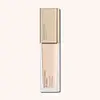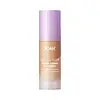What's inside
What's inside
 Key Ingredients
Key Ingredients

 Benefits
Benefits

 Concerns
Concerns

 Ingredients Side-by-side
Ingredients Side-by-side

Water
Skin ConditioningCyclopentasiloxane
EmollientPhenyl Trimethicone
Skin ConditioningC12-15 Alkyl Benzoate
AntimicrobialButylene Glycol
HumectantTalc
AbrasiveCetyl PEG/PPG-10/1 Dimethicone
EmulsifyingPolyglyceryl-4 Isostearate
EmulsifyingSodium Chloride
MaskingVinyl Dimethicone/Methicone Silsesquioxane Crosspolymer
Phenoxyethanol
PreservativePolymethylsilsesquioxane
Dimethicone/Vinyl Dimethicone Crosspolymer
Skin ConditioningDisteardimonium Hectorite
StabilisingSodium Dehydroacetate
PreservativeAlumina
AbrasiveHydrogen Dimethicone
Xanthan Gum
EmulsifyingAluminum Hydroxide
EmollientSodium Gluconate
Skin ConditioningEthylhexylglycerin
Skin ConditioningHelianthus Annuus Seed Oil
EmollientTocopherol
AntioxidantBeta-Sitosterol
Emulsion StabilisingSqualene
EmollientCI 77891
Cosmetic ColorantCI 77492
Cosmetic ColorantCI 77499
Cosmetic ColorantCI 77491
Cosmetic ColorantWater, Cyclopentasiloxane, Phenyl Trimethicone, C12-15 Alkyl Benzoate, Butylene Glycol, Talc, Cetyl PEG/PPG-10/1 Dimethicone, Polyglyceryl-4 Isostearate, Sodium Chloride, Vinyl Dimethicone/Methicone Silsesquioxane Crosspolymer, Phenoxyethanol, Polymethylsilsesquioxane, Dimethicone/Vinyl Dimethicone Crosspolymer, Disteardimonium Hectorite, Sodium Dehydroacetate, Alumina, Hydrogen Dimethicone, Xanthan Gum, Aluminum Hydroxide, Sodium Gluconate, Ethylhexylglycerin, Helianthus Annuus Seed Oil, Tocopherol, Beta-Sitosterol, Squalene, CI 77891, CI 77492, CI 77499, CI 77491
Water
Skin ConditioningPhenyl Trimethicone
Skin ConditioningButylene Glycol
HumectantDimethicone
EmollientCetyl PEG/PPG-10/1 Dimethicone
EmulsifyingOrbignya Oleifera Seed Oil
EmollientCyclopentasiloxane
EmollientButylene Glycol Dicaprylate/Dicaprate
EmollientButyloctyl Salicylate
Skin ConditioningGlycerin
HumectantDipropylene Glycol
HumectantMagnesium Sulfate
Cyclohexasiloxane
Emollient1,2-Hexanediol
Skin ConditioningAluminum Hydroxide
EmollientAnthemis Nobilis Flower Oil
MaskingCalcium Stearate
Cosmetic ColorantCaprylic/Capric Triglyceride
MaskingCerium Oxide
Cetyl Palmitate
EmollientCitric Acid
BufferingCollagen
MoisturisingDimethicone/Vinyl Dimethicone Crosspolymer
Skin ConditioningDisodium EDTA
Disteardimonium Hectorite
StabilisingEthylhexyl Palmitate
EmollientEthylhexylglycerin
Skin ConditioningHelianthus Annuus Seed Oil
EmollientHexyl Laurate
EmollientHyaluronic Acid
HumectantHydrogenated Lecithin
EmulsifyingHydrolyzed Hyaluronic Acid
HumectantIsopropyl Myristate
EmollientIsostearic Acid
CleansingLecithin
EmollientLeuconostoc/Radish Root Ferment Filtrate
AntimicrobialPalmitoyl Tetrapeptide-10
Skin ConditioningPolyglyceryl-3 Polyricinoleate
EmulsifyingPolyglyceryl-4 Isostearate
EmulsifyingPolyhydroxystearic Acid
EmulsifyingPolysorbate 80
EmulsifyingPotassium Sorbate
PreservativePropanediol
SolventPropylene Carbonate
SolventSilica
AbrasiveSodium Benzoate
MaskingSodium Chloride
MaskingSodium Hyaluronate
HumectantSorbitan Isostearate
EmulsifyingSorbitan Stearate
EmulsifyingStearic Acid
CleansingTocopherol
AntioxidantTocopheryl Acetate
AntioxidantTriethoxycaprylylsilane
Triethyl Citrate
MaskingTromethamine
BufferingTitanium Dioxide
Cosmetic ColorantCI 77492
Cosmetic ColorantWater, Phenyl Trimethicone, Butylene Glycol, Dimethicone, Cetyl PEG/PPG-10/1 Dimethicone, Orbignya Oleifera Seed Oil, Cyclopentasiloxane, Butylene Glycol Dicaprylate/Dicaprate, Butyloctyl Salicylate, Glycerin, Dipropylene Glycol, Magnesium Sulfate, Cyclohexasiloxane, 1,2-Hexanediol, Aluminum Hydroxide, Anthemis Nobilis Flower Oil, Calcium Stearate, Caprylic/Capric Triglyceride, Cerium Oxide, Cetyl Palmitate, Citric Acid, Collagen, Dimethicone/Vinyl Dimethicone Crosspolymer, Disodium EDTA, Disteardimonium Hectorite, Ethylhexyl Palmitate, Ethylhexylglycerin, Helianthus Annuus Seed Oil, Hexyl Laurate, Hyaluronic Acid, Hydrogenated Lecithin, Hydrolyzed Hyaluronic Acid, Isopropyl Myristate, Isostearic Acid, Lecithin, Leuconostoc/Radish Root Ferment Filtrate, Palmitoyl Tetrapeptide-10, Polyglyceryl-3 Polyricinoleate, Polyglyceryl-4 Isostearate, Polyhydroxystearic Acid, Polysorbate 80, Potassium Sorbate, Propanediol, Propylene Carbonate, Silica, Sodium Benzoate, Sodium Chloride, Sodium Hyaluronate, Sorbitan Isostearate, Sorbitan Stearate, Stearic Acid, Tocopherol, Tocopheryl Acetate, Triethoxycaprylylsilane, Triethyl Citrate, Tromethamine, Titanium Dioxide, CI 77492
Ingredients Explained
These ingredients are found in both products.
Ingredients higher up in an ingredient list are typically present in a larger amount.
Aluminum Hydroxide is a form of aluminum. It can be naturally found in nature as the mineral gibbsite. In cosmetics, Aluminum Hydroxide is used as a colorant, pH adjuster, and absorbent.
As a colorant, Aluminum Hydroxide may add opacity, or reduce the transparency. Aluminum hydroxide is contains both basic and acidic properties.
According to manufacturers, this ingredient is an emollient and humectant. This means it helps hydrate the skin.
In medicine, this ingredient is used to help relieve heartburn and help heal ulcers.
There is currently no credible scientific evidence linking aluminum hydroxide in cosmetics to increased cancer risk.
Major health organizations allow the use of aluminum hydroxide in personal care products and have not flagged it as a carcinogenic risk at typical usage levels.
Learn more about Aluminum HydroxideButylene Glycol (or BG) is used within cosmetic products for a few different reasons:
Overall, Butylene Glycol is a safe and well-rounded ingredient that works well with other ingredients.
Though this ingredient works well with most skin types, some people with sensitive skin may experience a reaction such as allergic rashes, closed comedones, or itchiness.
Learn more about Butylene GlycolThis ingredient is a high molecular weight silicone. It has emulsifying and skin conditioning properties.
Ci 77492 is also hydrated iron III oxide. It's sole purpose is to give a yellow hue to products.
Iron III oxides are classified as inorganic chemicals for coloring.
Synthetically created Ci 77492 is considered safer than those naturally found. This is because the synthetically created version may contain less impurities. Iron oxides are generally non-toxic and non-allergenic.
Learn more about CI 77492Cyclopentasiloxane, or D5, is a silicone used to improve texture of products and trap moisture.
D5 is considered lightweight and volatile. Volatile means it evaporates quickly after application. Once evaporated, D5 leaves a thin barrier that helps keep skin hydrated.
It is also an emollient. Emollients help soften the skin and prevent water loss. Silicones create a silky texture in products. D5 helps other ingredients become more spreadable.
Studies show D5 is safe to use in skincare products. We recommend speaking with a skincare professional if you have concerns.
Learn more about CyclopentasiloxaneThis ingredient is a silicone used to improve the texture of products and absorb oil. It does not get absorbed into the skin.
Like other silicones, Dimethicone/Vinyl Dimethicone Crosspolymer helps condition the skin by creating a barrier. In this sense, it can act as an emollient and trap moisture in.
This ingredient is a type of elastomer.
Learn more about Dimethicone/Vinyl Dimethicone CrosspolymerDisteardimonium Hectorite comes from the clay mineral named hectorite. It is used to add thickness to a product.
It can also help stabilize a product by helping to disperse other ingredients.
Hectorite is a rare, white clay mineral.
Learn more about Disteardimonium HectoriteEthylhexylglycerin (we can't pronounce this either) is commonly used as a preservative and skin softener. It is derived from glyceryl.
You might see Ethylhexylglycerin often paired with other preservatives such as phenoxyethanol. Ethylhexylglycerin has been found to increase the effectiveness of these other preservatives.
Helianthus Annuus Seed Oil is the oil derived from the seeds of a Sunflower. Sunflower seed oil is non-fragrant. It is an emollient, meaning it helps to soften the skin.
Sunflower seed oil contains many fatty acids. The fatty acids found in sunflower seeds include (from highest amount to least): linoleic acid, myristic acid, palmitic acid, stearic acid, arachidic acid, oleic acid, and linolenic acid.
These fatty acids help the skin create ceramides. Ceramides play a role in repairing the skin barrier.
Helianthus Annuus Seed Oil helps moisturize the skin. This in turn helps the skin look more rejuvenated and smoother.
Sunflowers are rich in vitamin E.
Historians believe Indigenous cultures of North America domesticated sunflowers before corn. Thus they relied on sunflower oil for a variety of uses. One such use is moisturizing skin and hair.
Sunflower seed oil may not be fungal acne safe. We recommend speaking with a professional if you have any concerns.
Learn more about Helianthus Annuus Seed OilPhenyl Trimethicone is a silicon-based polymer. It is derived from silica.
Phenyl Trimethicone is used as an emollient and prevents products from foaming.
As an emollient, it helps trap moisture in the skin. It is considered an occlusive.
Learn more about Phenyl TrimethiconeThis ingredient is an emulsifer and stabilizer. It comes from isostearic acid and polyglycerin.
As an emulsifier, it helps blend oil and water to improve texture, spreadbility, and application.
Due to it being derived from isostearic acid, this ingredient may not be fungal acne safe.
Learn more about Polyglyceryl-4 IsostearateChances are, you eat sodium chloride every day. Sodium Chloride is also known as table salt.
This ingredient has many purposes in skincare: thickener, emulsifier, and exfoliator.
You'll most likely find this ingredient in cleansers where it is used to create a gel-like texture. As an emulsifier, it also prevents ingredients from separating.
There is much debate on whether this ingredient is comedogenic. The short answer - comedogenic ratings don't tell the whole story. Learn more about comegodenic ratings here.
The concensus about this ingredient causing acne seems to be divided. Research is needed to understand if this ingredient does cause acne.
Scrubs may use salt as the primary exfoliating ingredient.
Learn more about Sodium ChlorideTocopherol (also known as Vitamin E) is a common antioxidant used to help protect the skin from free-radicals and strengthen the skin barrier. It's also fat soluble - this means our skin is great at absorbing it.
Vitamin E also helps keep your natural skin lipids healthy. Your lipid skin barrier naturally consists of lipids, ceramides, and fatty acids. Vitamin E offers extra protection for your skin’s lipid barrier, keeping your skin healthy and nourished.
Another benefit is a bit of UV protection. Vitamin E helps reduce the damage caused by UVB rays. (It should not replace your sunscreen). Combining it with Vitamin C can decrease sunburned cells and hyperpigmentation after UV exposure.
You might have noticed Vitamin E + C often paired together. This is because it is great at stabilizing Vitamin C. Using the two together helps increase the effectiveness of both ingredients.
There are often claims that Vitamin E can reduce/prevent scarring, but these claims haven't been confirmed by scientific research.
Learn more about TocopherolWater. It's the most common cosmetic ingredient of all. You'll usually see it at the top of ingredient lists, meaning that it makes up the largest part of the product.
So why is it so popular? Water most often acts as a solvent - this means that it helps dissolve other ingredients into the formulation.
You'll also recognize water as that liquid we all need to stay alive. If you see this, drink a glass of water. Stay hydrated!
Learn more about Water